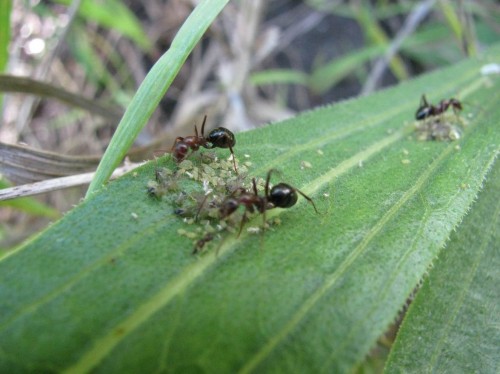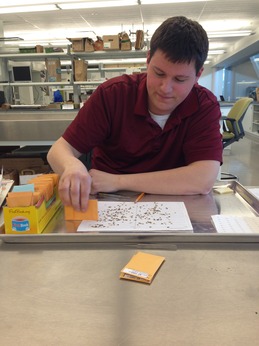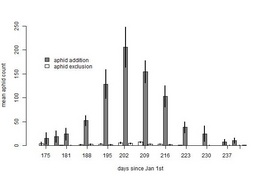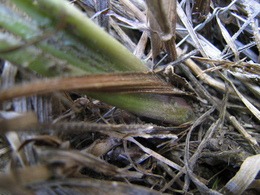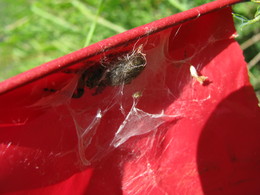|
|

In 2014, Cam Shorb continued an experiment designed to assess the effects of aphid herbivory on Echinacea angustifolia survival and fitness. The plants are located in experimental plot P1. Cam removed aphids from the 44 plants in the exclusion treatment and added over 220 aphids to the 43 plants in the addition treatment.
Read previous posts about this experiment.
Start year: 2011
Location: P1
Products: Fitness measurements were collected during our annual assessment of fitness in P1. A list of focal plants and addition/exclusion datasheets are located in Cam Shorb’s Dropbox folder.
Overlaps with: Overlaps with: Phenology and fitness in P1
Alex Yeaney, our intern from Lake Forest College this spring, finished up his report on the effects of a specialist aphid on Echinacea. Check out his report to find out his results!
AphidReport.pdf
It’s not actually madness in the lab right now. But we do have a few new things going on. Alex, a senior from Lake Forest College, starting working with us last week. He’ll be analyzing the achenes from heads in our aphids experiment. If you recall, this is an experiment that Katherine began in 2011 that involved adding or excluding aphids from 100 plants in the common garden. We’re interested if aphids have any effect on plant fitness and Alex will be looking at achene count and achene weight to see if there’s a difference between plants in our addition or exclusion treatments. He just started randomly sampling 30 achenes for the weigh machine today!

In other news, we’ve got our volunteers hard at work cleaning and counting. We’re still working on counts from 2011, BUT we’re making progress.
During the summers of 2011 and 2012, I conducted a survey of aphid infestation in a section of the main experimental plot to track, among other things, seasonal changes in the distribution and abundance of Aphis echinaceae on Echinacea. With help from members of team Echinacea, I conducted 6 bi-weekly surveys in 2011 and 3 monthly surveys in 2012. In both years there was a sharp rise and fall in the frequency of aphid infestation. The plot below shows the percentage of plants in the survey area observed to have 1 or more aphids on each dates. In 2011, the peak of aphid infestation (i.e. when the highest percentage of plants hosted aphids) was around August 12th. In 2012, the peak date of aphid infestation occurred some time between July 13th and August 9th. I was not able to observe the peak directly due to a sudden die-off of aphids before my third survey. I estimated the peak frequency of aphids as the percentage of plants with live or dead aphids on August 10th (indicated by the asterix and x-error bar).

I was also able to get a sense of aphid phenology from my aphid addition/exclusion experiment. In 2011 and 2012, I added or excluded aphids from 100 plants that were not flowering in 2011. The graph below shows the mean abundance of aphids in each experimental group over the summer of 2012:

Based on this graph, I estimate that the peak of aphid infestation for 2012 occurred around July 22nd (202 days after January 1st), about two weeks before last year’s peak.
Like their hosts, Echinacea aphids exhibit a strong seasonality. There’s a sharp rise in the frequency and abundance of aphid infestation followed by a rapid decline in early fall. That decline has occurred much earlier this year than last year. Fortunately, that has given me a chance to make some observations about what happens to aphids at the end of the summer. Here are a few things I’ve noticed:
1. Throughout my surveys in CG1 and several prairie remnants, I’ve noticed that the frequency of winged morphs has declined since July. Last week, I did not see any winged aphids, with the exception of a couple at East Elk Lake Road. This implies that dispersal declines as aphid numbers drop.
2. I and several others have noticed that aphids are starting to congregate at the base of the plant both at the petioles and at the base of the stem. I’ve also seen aphids crawling down beneath the soil surface and a few latched onto the tops of roots. One possibility is that as plants withdraw resources from their leaves, aphids move down the plant to follow their food source. I’ve also seen ants moving aphids at the base of the plant and placing them in dirt structures. These observations support the notion that aphids overwinter on Echinacea roots.
Many aphid species in temperate regions spend the winter and summer on different plants. Their winter host is where they lay eggs and their summer host is where they feed and reproduce asexually. My guess is that Aphis echinaceae does not have a separate winter host.
This plant at Nessman’s had a bunch of aphids congregated at the base. Notice the little green guys on the stem:

This is one of the plants from my aphid addition/exclusion experiment in CG1. There are still aphids on the leaves, but most of them have moved to the petioles:

After last week’s sultry weather, we’ve been enjoying a “dry heat”, as Greg Diersen so artfully put it. This morning everyone went their separate ways to pursue their individual projects:
Shona, Maria, and Lydia went directly to Hegg Lake and combined forces to measure plants and take GPS points. Shona also photographed Echinacea pallida and E. angustifolia plants as part of her project to assess species traits.
Andrew searched the main experimental plot (C1) for plants where he can observe pollinators. Because peak flowering has passed, his selection of flowering heads is growing slimmer by the day. Fortunately, he has some good observations under his belt and will be able to collect more before plants stop flowering.
Jill and Greg joined forces in operation pit-fall trap. Greg’s traps are bowls full of soapy water that he sets on the ground and leaves out for a couple of days. Jill’s are tubes full of propylene glycol that she submerges in the soil and leaves out for a week. Today, they set out Greg’s traps and collected from Jill’s. I have to say: the smell of dead insects stewing in propylene glycol for a week is probably one of the worst smells I have experienced.
I spent the morning removing aphids from plants in my aphid addition/exclusion experiment. Even though it has been three days since my last exclusion, there were aphids on 11 out of 50 plants in my exclusion group. One plant had 67 aphids–all in three days! Those aphids are moving and breeding fast.
This afternoon we joined together in our common goal of measuring every plant in C1. My mother used to say that the only way to eat an elephant is one bite at a time. Well, today we bit a big chunk off of our elephant, finishing up the sections planted in 1997, 1998, and 1999. We have less than half an elephant to go!
And now for a picture. In addition to helping us keep track of plants, pin flags make great habitat for spiders:

Last summer I conducted a biweekly survey of aphids and ants in the common garden, an experimental prairie restoration containing Echinacea from various remnant populations. I was interested in the spatial distribution of aphids and ants within and across years. This year I plan to scale down my survey to once a month, beginning next Friday. Here’s a detailed protocol:
Common Garden Aphid Survey Protocol 2012.doc
I couldn’t make the Midwest Ecology and Evolution Conference, but I made a poster. It describes preliminary results from an aphid addition/exclusion experiment I conducted in the summer of 2011. Specifically, it examines the question of whether aphid infestation influences the presence of leaf damage by other herbivores.
MEECPosterKMullerFinal.pdf
It’s been a busy week for everybody. Plants are blooming, pollen is shedding, and everyone is dashing about madly to catch the field season before it passes us by. I have been running around like a chicken with its head cut off trying to get ready for my aphid addition/exclusion experiment. Everyone has been a wonderful help setting up cages in this sweltering heat. My goal for this week is to finish my first round of experimental treatments: exclusion on Thursday and addition on Friday. Before then, I need to finish setting up nets and teach everyone how to wrangle aphids. Here is a protocol I wrote up to assist the teaching process and the data sheets I mention in the protocol. These are works in progress, so any feedback is appreciated.
AphidExclusionCollectionProtocol2011.doc
aphidexclusion.xls
aphidcollectionoutsideExpt.xls
aphidinfestation.xls
Happy wrangling,
Katherine
View image
|
|

